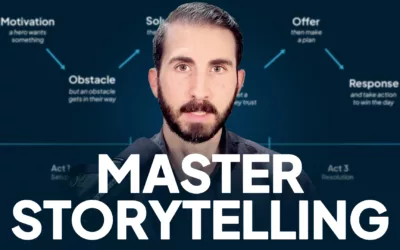Why do we call these the “laws” of marketing instead of strategies or tactics?
Think about building a bridge. If you don’t know the laws of physics, you might be able to build a small bridge that holds one person.
But you’ll never build something like the Golden Gate Bridge without understanding those laws.
The same principle applies to marketing.
Your business needs a bridge between you and your customers. That’s what marketing is—a way for them to discover you and eventually buy from you.
If your marketing strategies don’t follow the laws of marketing, your “bridge” won’t hold the weight.
Just like what would happen if you ignored the laws of physics.
A marketing strategy might work for someone else, but if they don’t understand these laws, they can’t help you build something sustainable.
They don’t know if they got results due to skill or just dumb luck. And most folks will immediately assume it was skill.
These laws are the foundation of all marketing strategies and tactics. Once you grasp them, you’ll be able to evaluate whether specific approaches could actually work for you or not.
If you know enough about physics, you can look at a bridge and have a decent idea whether it will hold your weight—before you risk your neck by trying to use it to cross a river.
Let’s dive into each one.
1. Build Memories
When someone goes to buy something, memories play a huge role in their decision. If a customer has seen your brand before—even if they don’t consciously remember it—they’re more likely to choose you over a competitor.
When a potential customer enters the market for your product or service, they start with the category as a whole—not your specific brand.
For example, someone looking for ice cream for the first time doesn’t have a favorite brand yet. But if they’ve encountered your brand through ads or word of mouth, they’ll have a preference for you.
The ultimate goal is to build enough mental real estate that they skip comparing competitors altogether and go straight to you.
Building memories comes down to two key components. One is your ability to tell a clear story. The second is your brand’s use of distinctive design.
Tell a Clear Story
Use storytelling to connect emotionally with your audience. Facts might inform, but stories sell.
Break your story into three acts: the setup (what’s happening in your customer’s world), the solution (how your product or service helps), and the resolution (how their problem gets solved).
Leverage Distinctive Design
Make your brand recognizable. Use consistent colors, fonts, and design elements. Think about Geico’s gecko or Allstate’s Mayhem campaign. Consistency builds recognition over time.
Without clear storytelling and a distinctive design, your efforts to reach potential customers will fall flat. Why? Because they simply won’t remember you.
2. Maximize Availability
If people can’t find you, they can’t buy from you. Ask yourself the following question: are you available where people are looking for what you sell?
This law has two key principles.
Be Easy to Find
Figure out where your potential customers look when they’re searching for your product or service. Is it Google search? Amazon? Recommendations from a business coach? Wherever they are, you need to show up there.
Examples:
- If you’re in home services, make sure you’re on Google My Business, Yelp, or even Nextdoor.
- If you sell physical products, being on Amazon might be key, as some customers skip Google altogether and search directly on Amazon.
Be Easy to Buy
Once they find you, make the buying process simple. Have a well-designed website, clear pricing, and make navigation straightforward.
If you’re selling ice cream, your pricing needs to align with competitors in your category.
If your competitors are offering free shipping, consider doing the same.
Maximizing availability is about being present and available when customers come to you. Make sure your products or services are available in the same places you would go to look for them if you were the customer.
3. Reach the Market
Reaching the market is the opposite of Maximizing Availability. When you maximize availability, you’re putting your products in places where your customers would search for them. But to reach the market, you have to go to your customers instead.
Advertising is a big part of this law, and reaching the market can be broken down into two key ideas.
Reach All Users
Think beyond your “ideal customer” avatar. Target the broadest possible audience for your product or service.
For example, only 3.5% of Harley Davidson’s sales come from the stereotypical leather-jacket-wearing biker. They can’t ignore people who don’t match this profile, or they’re leaving more than 90% of their business on the table.
Similarly, Coca-Cola gets 50% of its revenue from people who buy less than one can per year. If they only marketed towards people who buy a can every day, they’d miss out on half of their revenue.
To put it simply, broad targeting can be more effective and cost-efficient than highly targeted marketing focused on a single, specific user profile.
Focus On Uses
Think about how people use your product or service. Why do they buy it? Where do they use it? Who are they with when they use it?
These are critical questions because they help you understand the role your product plays in their lives.
For example, Apple’s iPhone initially served three main purposes: phone, internet access, and music storage.
But over time, Apple expanded its uses. The iPhone became a camera, a health tracker, and even a safety tool with satellite connectivity.
Each new feature gives customers more reasons to buy and increases the number of ways they could use the product.
You don’t have to add new uses immediately. Start by focusing on the ways customers already use what you sell.
Over time, as your business grows, you can explore additional features or applications that make your product even more valuable.
Think of it this way: every new use is another reason for someone to choose you.
4. Test and Validate
The fourth law of marketing, Test and Validate, is central to everything. Picture a triangle: on the left side, we have Build Memories; on the right, Maximize Availability; across the bottom, Reach the Market. At the center is Test and Validate—the foundation that ties it all together.
Why is this law so important? Because the truth is, in business and marketing, nobody gets everything right on the first try. Success isn’t about starting right—it’s about becoming right. Testing and validating your strategies ensures that mistakes are caught early and adjustments can be made before they become costly.
Hubris, or overconfidence, is one of the fastest ways to fail. As Jim Collins explains in How the Mighty Fall, “hubris born of success” often leads companies astray. Testing and validating ideas combats this by forcing you to get the data rather than relying on opinions or “feel.”.
If you’re not testing, you’re guessing. And in business, guessing is dangerous. Testing and validating every decision ensures you’re constantly moving toward the right answers and avoiding costly mistakes.
Test Small
The first step in testing and validating is to test small. When you’re trying something new—whether it’s a marketing initiative, messaging tweak, or a completely different strategy—the question is: how can you test this in the smallest, safest way possible?
Jim Collins’ Great by Choice offers a valuable perspective here. Unlike Good to Great, which focuses on established companies turning things around, Great by Choice studies businesses—like early-stage Microsoft—that thrived amidst chaos. One of the book’s key conclusions is the importance of minimizing risk when testing new ideas.
Imagine you have $100,000 in the bank. Your CEO proposes a bold new marketing strategy and is so confident they want to spend the entire $100,000 on it. If they’re wrong, the business is in serious trouble. Testing small avoids these high-stakes risks. Instead of betting everything, you could allocate $5,000 to a pilot campaign, pause to evaluate results, make adjustments, and test again.
Here’s how it works:
- Start with a small, controlled test. For example, spend a modest budget on ads or target a specific segment of your audience.
- Pause and assess results. Is it working? What needs tweaking?
- Iterate and test again, gradually increasing the investment only if you’re seeing positive outcomes.
Testing small isn’t just about money; it’s also about time. Spend the least amount of resources—whether it’s hours or dollars—while still gaining meaningful insights.
I had a friend who had to decide if they wanted to spend $30,000 on advertising at a conference. Even with $300,000 in the bank, they carefully evaluated the risks before proceeding. This mindset of testing small—whether the investment is $5,000, $500, or even just your time—keeps your business safe while allowing you to experiment and learn.
But remember, the definition of “small” varies by business size.
For a billion-dollar company, a small test might mean spending millions.
For a smaller business, it could mean nothing more than an A/B test on your website.
The principle stays the same: start small to minimize risk and protect your business while validating ideas.
Once your small test has provided enough data to confirm an idea works, it’s time to make a decision.
When you validate an idea, you’re moving from cautious experimentation to full implementation. This is when you allocate larger resources, pump up your efforts, and commit to making the idea a key part of your strategy.
But validation also means being ready to pivot or shut something down if the test reveals it’s not viable.
Here’s an example of what can happen when validation is ignored:
At ClearBrand, we experimented with pay-per-lead marketing as a service. The initial goal was to keep it small—a minor percentage of our revenue.
But once we added the option to our website, it became so popular that nearly all our sales calls were about pay-per-lead marketing.
For 18 months, we tested the viability of this service and ultimately realized it wasn’t the right fit for us. The profit margins were too low, and the clients it attracted weren’t aligned with our long-term goals.
When we decided to exit this offering, we faced a challenge: we had become known primarily for pay-per-lead marketing. Rebuilding our pipeline for other services took time and effort—something we could have avoided if we had better controlled the scale of the test.
What should we have done? Kept the test small.
For instance, limiting its visibility or taking the pay-per-lead page down after a certain number of leads could have preserved the balance of our revenue streams while still gathering valuable data.
If the service had proven viable, we could have scaled it up strategically, making it a larger focus of our business.
Go Big (Or Shut It Down)
Once you’ve validated an idea, act decisively. If it works, go big. Invest more resources, amplify your efforts, and integrate the successful strategy into your business model.
If it doesn’t work, shut it down and move on.
Validation isn’t limited to large-scale changes. For example, a friend testing the viability of an online course used Facebook ads to direct users to a landing page.
The page mimicked a payment process but ultimately added people to a waitlist. This allowed them to measure interest before committing to building the course. When the results showed strong demand, they created and launched the course with confidence.
Validation is about making data-driven decisions, whether it’s a marketing campaign, product offering, or new service. It helps to make sure you’re scaling what works and avoiding wasted effort on what doesn’t.
Once you validate a test, don’t hesitate. Scale with confidence if it works—or pivot quickly if it doesn’t.
Build An Effective Marketing Strategy Using The 4 Laws Of Marketing
Marketing success is about understanding the foundational laws that guide every effective campaign.
Building memories, maximizing availability, reaching the market, and rigorously testing and validating your efforts, is how you can create marketing strategies that truly connect with your audience and drive results.
At ClearBrand, we specialize in helping businesses like yours apply these principles to build sustainable growth.
If you’re ready to elevate your marketing and bridge the gap between your business and your customers, schedule a free strategy call with us today or explore our free resources at ClearBrand.com.







